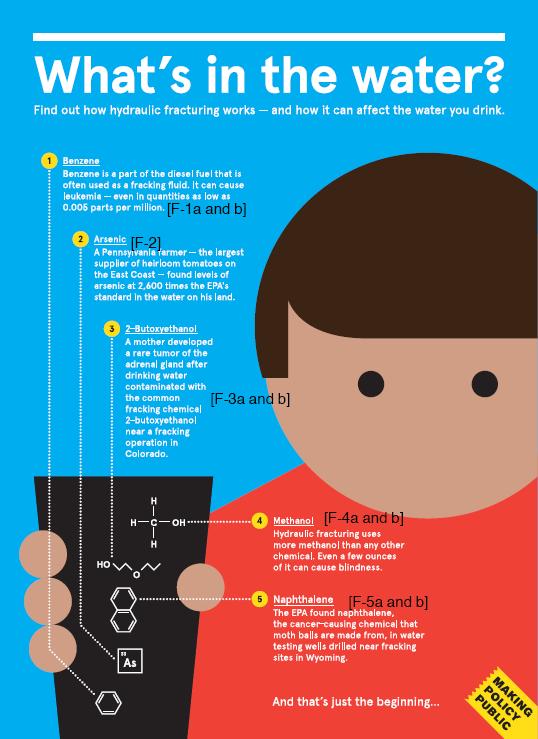Download the poster with references as a pdf.
References for any information on the poster are also available on request.

Benzene – Benzene is a part of the diesel fuel that is often used as a fracking fluid. [F -1a]
It can cause leukemia – even in quantities as low as 0.0005 parts per million. [F -1b]
[F-1a] benzene in diesel – https://www.globalsecurity.org/military/systems/ship/systems/diesel-fuel.htm
diesel in fracking fluid – https://www.propublica.org/article/drilling-industry-says-diesel-use-was-legal
both parts of F-1a ; https://www.ewg.org/research/drilling-around-the-law
[F-1b] benzene causes leukemia
https://www.ncbi.nlm.nih.gov/pmc/articles/PMC1469721/
[F-2]
Arsenic – A Pennsylvannia farmer – the largest supplier of heirloom tomatoes on the East Coast – found levels of arsenic at 2,600 times the EPA’s Standard in the water on his land.
[F-3]
2-Butoxyethanol – A mother developed a rare tumor of the adrenal gland after drinking water contaminated with the common fracking chemical 2-butoxyethanol, near a fracking operation in Colorado.
[F-3a] 2-butoxyethanol is a common fracking chemical AND has health impacts
2-Butoxyethanol (2-BE), also known as ethylene glycol monobutyl ether (EGBE) (CAS No. 111-76-2), is a surfactant used in many phases of gas exploration and extraction. It comprises a considerable percentage of Airfoam HD, commonly used for air-lubricated drilling (47). Easily absorbed through the skin, this chemical has long been known to be selectively toxic to red blood cells; it causes them to rupture, leading to hemorrhaging (48). More recently, the ability of EGBE at extremely low levels (ppt) to cause endocrine disruption, with effects on ovaries and adrenal glands, is emerging in the medical literature (49). This chemical is only moderately toxic to aquatic organisms, with harm to algae and test fish observed with doses over 500 ppm (48).
[F-4]
Methanol – Hydraulic fracturing uses more methanol than any other chemical. Even a few ounces of it can cause blindness.
[F-4a] Hydraulic fracturing uses more methanol than any other chemical.
[F-4b] Methanol toxicity – “Methyl Alcohol.” Material Safety Data Sheet. 14 Feb 2001. Iowa State University. 20 May 2009.
[F-5]
Naphthalene – The EPA found naphthalene, the cancer-causing chemical that moth balls are made from, in water testing wells drilled near fracking sites in Wyoming.
[F-5a] The EPA found naphthalene in water testing wells drilled near fracking sites in Wyoming.
Discussion of same: https://www.nytimes.com/2011/12/09/us/epa-says-hydraulic-fracturing-likely-marred-wyoming-water.html?_r=0


